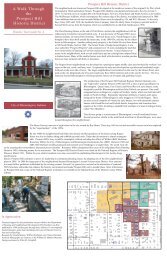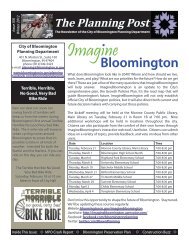Peak Oil Task Force Report - City of Bloomington - State of Indiana
Peak Oil Task Force Report - City of Bloomington - State of Indiana
Peak Oil Task Force Report - City of Bloomington - State of Indiana
Create successful ePaper yourself
Turn your PDF publications into a flip-book with our unique Google optimized e-Paper software.
fertility inputs and yields <strong>of</strong> surplus biomass would need to be harvested from non‐<br />
croplands throughout the region. Assuming that most <strong>of</strong> the 60 percent <strong>of</strong> the region's land<br />
area not in prime farmland is wooded or could be sown to compost crops, it is likely that a<br />
regenerative agricultural system for the region could be designed and implemented given<br />
sufficient cooperation and willingness. Of course, the best innovative techniques for soil<br />
fertility management and biointensive production should be employed. Yet, even without<br />
these potential improvements to productivity, it seems likely that the region could feed<br />
itself if other factors <strong>of</strong> production could be mobilized.<br />
Factors Which Moderate Food Demand<br />
While we’ve determined that the agricultural land base <strong>of</strong> <strong>Bloomington</strong>’s seven‐county<br />
region is sufficient to provide <strong>Bloomington</strong> and its neighbors with a healthy diet, we’ve<br />
come to this conclusion in light <strong>of</strong> the following factors which moderate local food demand.<br />
1. Many students at <strong>Indiana</strong> University and other area colleges depart the region for<br />
travel, study, or to return home to family during breaks, reducing by several<br />
percentage points the food requirements <strong>of</strong> the area. In the event that food<br />
shortages emerge as a chronic social condition, the resident population may be<br />
reduced as students seek refuge with their families in other parts <strong>of</strong> the state or the<br />
nation.<br />
2. The American diet is widely acknowledged to be excessive and most people could<br />
live better and longer on somewhat less food. Sugars and bad fats could be reduced<br />
with an expected increase in health, and perhaps less hunger, as these empty<br />
calories <strong>of</strong>ten strip the body <strong>of</strong> nutrients and leave it craving even more food.<br />
3. Much less meat and dairy in the diet could be anticipated in the event <strong>of</strong> extreme<br />
conditions. Price increases for these energy‐ and land‐intensive foods will tend to<br />
reduce consumption, even absent shortages. This change alone would dramatically<br />
reduce the amount <strong>of</strong> land required to feed the regional population <strong>of</strong> 350,000.<br />
4. Conventional American agriculture uses little labor but much land, energy, and<br />
capital. Home gardening produces 2‐7 times as much food per acre as commercial<br />
farming. Jeavons' biointensive gardening methods produce 11 times the fruits and<br />
vegetables per unit <strong>of</strong> land as conventional American agriculture. (Indeed, using<br />
Jeavons’ method, Jules Dervaes and his family raise 6,000 lbs. <strong>of</strong> food annually on<br />
<strong>Report</strong> <strong>of</strong> the <strong>Bloomington</strong> <strong>Peak</strong> <strong>Oil</strong> <strong>Task</strong> <strong>Force</strong> 186









